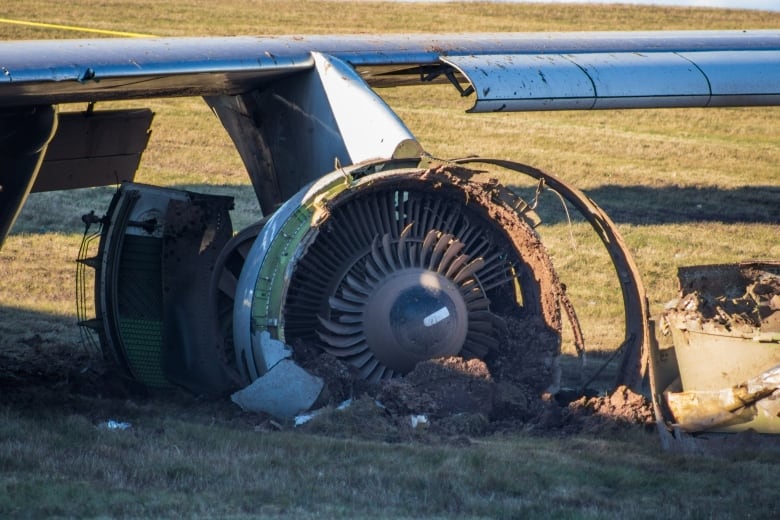Poor communication, crew fatigue factors in 2018 Halifax cargo jet runway overrun
Plane went past end of runway, stopping 47 metres from public road

Fatigue, poor communication, and an unexpected tailwind contributed to a cargo plane crash at the Halifax Stanfield International Airport in 2018, according to a Transportation Safety Board of Canada report released Tuesday morning.
On Nov. 7, 2018, a Sky Lease Cargo plane landing at the Halifax airport from Chicago went off the tarmac and came to a stop 270 metres past the end of the runway, 47 metres short of a fence separating the airport from a public road.
The report says the three-person crew of the Boeing 747-412F was "experiencing sleep-related fatigue that degraded their performance and cognitive functioning during the approach and landing."
Unfortunately, one expert says such fatigue is a common problem that is pervasive throughout commercial and military aviation.
Jock Williams, a retired Canadian Forces fighter pilot and former flight safety official for Transport Canada, said terrible work schedules are to blame for pilot's fatigue.

"You may have been awake for the last 24 hours," Williams told CBC News on Tuesday.
"Although your eyes are open and you think you're thinking clearly, your reflexes and overall performance are just not as high as they might be."
The scheduling of the flight, which landed just after 5 a.m. AT, did not allow the crew to get enough sleep in the 24-hour period leading up to the trip.
Poor communication in the notices to airmen (NOTAM) documents — which inform pilots about anything that could affect safety or operations at airports — was also a factor in the overrun, the report says.
The crew reviewed 98 NOTAMs for the flight, including 37 for the Halifax airport. The NOTAMs warned that part of runway 23 was closed due to painting and repairs to lighting.
Even though the remaining length of the runway would have been sufficient for the landing, the crew concluded that the runway was not available to them because of the use of the wording "NOT AUTH" (not authorized) in one document.
The TSB report says the NOTAMs were not presented in an easily digestible format. The reports were not sequenced based on importance, but rather chronologically. They were also repetitive, so the crew would have had to flip back and forth to determine what was different about each one and note the relevant changes.
Additionally, the report says, the NOTAMs were written in all capital letters, which "prove difficult for readability and interpretation."
In 2019, NAV CANADA started using a different format for NOTAMs — one that was already used by most countries — that reduces clutter and helps pilots access just the pertinent information.
Since the crew concluded that runway 23, which was 3,200 metres long, was unavailable, they decided to use runway 14, which was 2,347 metres long.
Air traffic control in Halifax did not directly communicate with the crew about which runway was active, although the information was contained in an automatic terminal information service broadcast.
"As a result, the crew continued to believe that the approach and landing to runway 14 was the only option available."

The crew recognized the presence of a tailwind shortly before landing, but it was not enough time to recalculate its performance data to confirm that it was safe to land.
After the touchdown, "for undetermined reasons," one lever was in the wrong position, causing the speed brakes to retract and the autobrake system to disengage, which increased the distance the plane would need to come to a stop.
Although the manual brake was applied eight seconds after touchdown, the maximum braking effort didn't occur until 15 seconds later, when the plane was about 240 metres from the end of the runway.
"At this position, it was not possible for the aircraft to stop on the runway, and, five seconds later, the aircraft departed the end of the runway at a speed of [143 kilometres per hour] and came to a stop 270 metres (885 feet) past the end of the runway," the report says.

Williams said the fact the brakes weren't applied to the maximum until 15 seconds after touchdown was a major mistake, and shows a lack of communication between the pilots.
The co-pilot was more concerned with the fact that the plane was veering off from the centre of the runway, Williams said.
"He started talking about that, instead of saying to the pilot, 'Slow down,'" Williams said.
"Their co-ordination style, the way the two pilots interacted … frankly, left a lot to be desired."
After it left the tarmac, the plane went down a drop of 2.8 metres and was "damaged beyond repair."
The board says the slope of the ground in the area past runway 14 at the Halifax airport is 73 per cent, whereas the International Civil Aviation Organization recommends a slope no greater than five per cent.
The jet hit some light stanchions and an antenna array, and as it came to a stop, a fire broke out when an engine became detached and got lodged under the tail section of the plane.
The TSB report notes that runway overruns and fatigue management are two of the issues on the board's list of key safety issues that need to be addressed to make transportation safer.
The board is calling on Transport Canada to adopt international standards for runway end safety areas, including the use of arresting systems designed to stop aircraft.
With files from Amy Smith